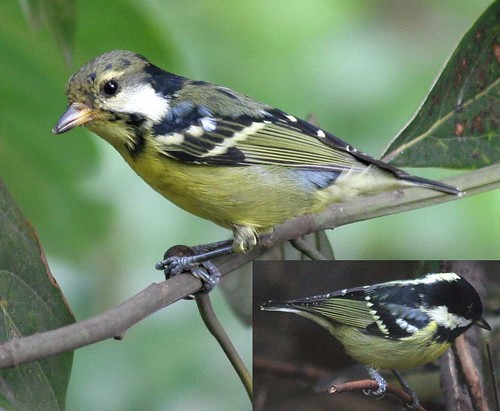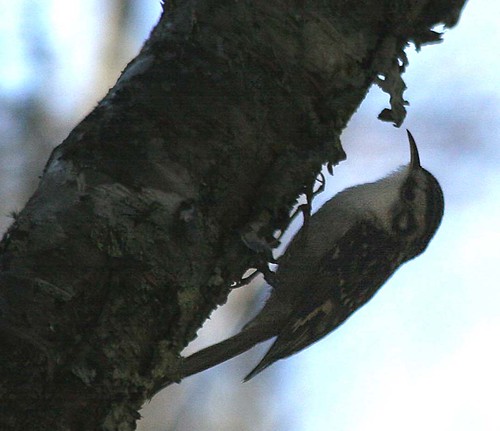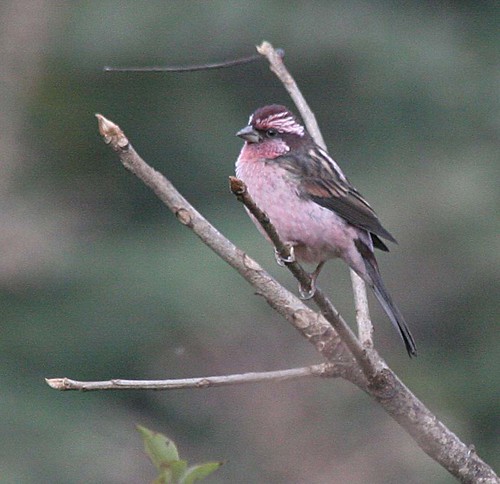Chengdu Bird guiding – [email protected] - Chengdu, Sichuan, the gateway to Tibet - to see more travel pics of Sichuan go to my travel blog at - http://chengdutravel.blogspot.com/
To see more of our birding pics go to - http://sichuanbirds.blogspot.com/

Yellow-bellied Tit - Immature with adult in the inset. This is a China endemic that can be commonly found in the parks of Chengdu.
We've been busy over the last week with work - which have seen me having to use a good deal of my time sitting behind a computer. But luckily I've also had the chance to add to our Sichuan bird blog - http://sichuanbirds.blogspot.com/ - with an article that, among other things, shows that more China endemics can be found in Sichuan than any other part of the country.
One of the interesting things I unearthed on the net was this map, that's included in an article relating to the distribution of endemics within China (http://www.springerlink.com/content/r41645v6u5272v20/fulltext.pdf - originating from the Institute of Zoology, Bejing).

The map of China is color coded to show how endemics are distributed - and according to this chart Sichuan is shown to contain China's major endemic hotspot - the Hengduanshan Mountain range (I've colored the border of Sichuan in red).
This range that encompasses Eastern Tibet, Western Sichuan and North West Yunnan - the mountains that mark the eastern edge of the Tibetan Plateau can include the following species in the list of endemics found there -
1. Severtzov's Grouse Bonasa sewerzow
2. Chestnut-throated Partridge Tetraophasis obscurus
3. Chinese Monal Lophophorus lhuysii
4. Blue Eared-Pheasant Crossoptilon auritum
5. Golden Pheasant Chrysolophus pictus
6. Père David's Owl Strix davidi
7. Chinese Thrush Turdus mupinensis
8. Crested Tit-Warbler Leptopoecile elegans
9. Hodgson's Redstart Phoenicurus hodgsoni (breeding endemic)
10. Rufous-headed Robin Luscinia ruficeps (breeding endemic)
11. Yunnan Nuthatch Sitta yunnanensis
12. Rufous-tailed babbler Chyrsomma poecilotis
13. Père David's (Plain) Laughingthrush Garrulax davidi
14. Sukatschev's (Snowy-cheeked) Laughingthrush Garrulax sukatschewi
15. Barred Laughingthrush Garrulax lunulatus
16. Biet's Laughingthrush Garrulax bieti
17. Giant Laughingthrush Garrulax maximus
18. Chinese Fulvetta Alcippe striaticollis
19. Three-toed Parrotbill Paradoxornis paradoxus
20. Rusty-throated Parrotbill Paradoxornis przewalskii
21. Spectacled Parrotbill Paradoxornis conspicillatus
22. Sooty Tit Aegithalos fuliginosus
23. White-browed Tit Poecile superciliosa
24. Père David's (Rusty-breasted) Tit Poecile davidi
25. Sichuan Treecreeper Certhia tianquanensis
26. Sichuan Jay Perisoreus internigrans
27. Pink-rumped Rosefinch Carpodacus eos
28. Three-banded Rosefinch Carpodacus trifasciatus (breeding endemic)

Sichuan Treecreeper - distinguished by shorter bill, white chin and brown belly. This is not just a China endemic but at the moment a Sichuan endemic- although earlier this year we spotted them very near the Yunnan border so I should think these birds are not just restricted to our province.
Slightly to the east of the Hengduanshan range - the mountains of Emei and Wawu also house an impressive list of endemics that include some notable species-
1. Emei Leaf-Warbler Phylloscopus emeiensis
2. Sulphur-breasted Warbler Phylloscopus ricketti (breeding endemic)
3. Martens's Warbler Seicercus omeiensis
4. Sichuan Treecreeper Certhia tianquanensis
5. Rusty (Buffy) Laughingthrush Garrulax poecilorhynchus
6. Emeishan Liocichla Liocichla omeiensis
7. Gray-hooded Parrotbill Paradoxornis zappeyi
8. Three-toed Parrotbill Paradoxornis paradoxus
9. Slaty Bunting latoucheornis siemsseni
while close by on Laojunshan is the last known strong hold of endemic Sichuan Partridge Arborophila rufipectus - and has a population of Gold-fronted Fulvetta Alicippe variegaticeps
Even in Chengdu we get our endemics - Yellow-bellied Tits Parus venustulus being common in certain parks, and Slaty Bunting latoucheornis siemsseni a winter visitor

And as time goes on - as more sub-species are split off to be classified as specific species in their own rite - the number of endemics in Sichuan will increase. Above is a picture Meggie took, in the Moxi area, of a Rosefinch we had great trouble in identifying. Only through Birdforum - and the expert help of James Eaton - did we get to discover that this is a form of Spot-winged Rosefinch that has already been recognised and named by some authorities as a seperate species called - Sharpe's Rosefinch.
To see more of our birding pics go to - http://sichuanbirds.blogspot.com/

Yellow-bellied Tit - Immature with adult in the inset. This is a China endemic that can be commonly found in the parks of Chengdu.
We've been busy over the last week with work - which have seen me having to use a good deal of my time sitting behind a computer. But luckily I've also had the chance to add to our Sichuan bird blog - http://sichuanbirds.blogspot.com/ - with an article that, among other things, shows that more China endemics can be found in Sichuan than any other part of the country.
One of the interesting things I unearthed on the net was this map, that's included in an article relating to the distribution of endemics within China (http://www.springerlink.com/content/r41645v6u5272v20/fulltext.pdf - originating from the Institute of Zoology, Bejing).

The map of China is color coded to show how endemics are distributed - and according to this chart Sichuan is shown to contain China's major endemic hotspot - the Hengduanshan Mountain range (I've colored the border of Sichuan in red).
This range that encompasses Eastern Tibet, Western Sichuan and North West Yunnan - the mountains that mark the eastern edge of the Tibetan Plateau can include the following species in the list of endemics found there -
1. Severtzov's Grouse Bonasa sewerzow
2. Chestnut-throated Partridge Tetraophasis obscurus
3. Chinese Monal Lophophorus lhuysii
4. Blue Eared-Pheasant Crossoptilon auritum
5. Golden Pheasant Chrysolophus pictus
6. Père David's Owl Strix davidi
7. Chinese Thrush Turdus mupinensis
8. Crested Tit-Warbler Leptopoecile elegans
9. Hodgson's Redstart Phoenicurus hodgsoni (breeding endemic)
10. Rufous-headed Robin Luscinia ruficeps (breeding endemic)
11. Yunnan Nuthatch Sitta yunnanensis
12. Rufous-tailed babbler Chyrsomma poecilotis
13. Père David's (Plain) Laughingthrush Garrulax davidi
14. Sukatschev's (Snowy-cheeked) Laughingthrush Garrulax sukatschewi
15. Barred Laughingthrush Garrulax lunulatus
16. Biet's Laughingthrush Garrulax bieti
17. Giant Laughingthrush Garrulax maximus
18. Chinese Fulvetta Alcippe striaticollis
19. Three-toed Parrotbill Paradoxornis paradoxus
20. Rusty-throated Parrotbill Paradoxornis przewalskii
21. Spectacled Parrotbill Paradoxornis conspicillatus
22. Sooty Tit Aegithalos fuliginosus
23. White-browed Tit Poecile superciliosa
24. Père David's (Rusty-breasted) Tit Poecile davidi
25. Sichuan Treecreeper Certhia tianquanensis
26. Sichuan Jay Perisoreus internigrans
27. Pink-rumped Rosefinch Carpodacus eos
28. Three-banded Rosefinch Carpodacus trifasciatus (breeding endemic)

Sichuan Treecreeper - distinguished by shorter bill, white chin and brown belly. This is not just a China endemic but at the moment a Sichuan endemic- although earlier this year we spotted them very near the Yunnan border so I should think these birds are not just restricted to our province.
Slightly to the east of the Hengduanshan range - the mountains of Emei and Wawu also house an impressive list of endemics that include some notable species-
1. Emei Leaf-Warbler Phylloscopus emeiensis
2. Sulphur-breasted Warbler Phylloscopus ricketti (breeding endemic)
3. Martens's Warbler Seicercus omeiensis
4. Sichuan Treecreeper Certhia tianquanensis
5. Rusty (Buffy) Laughingthrush Garrulax poecilorhynchus
6. Emeishan Liocichla Liocichla omeiensis
7. Gray-hooded Parrotbill Paradoxornis zappeyi
8. Three-toed Parrotbill Paradoxornis paradoxus
9. Slaty Bunting latoucheornis siemsseni
while close by on Laojunshan is the last known strong hold of endemic Sichuan Partridge Arborophila rufipectus - and has a population of Gold-fronted Fulvetta Alicippe variegaticeps
Even in Chengdu we get our endemics - Yellow-bellied Tits Parus venustulus being common in certain parks, and Slaty Bunting latoucheornis siemsseni a winter visitor

And as time goes on - as more sub-species are split off to be classified as specific species in their own rite - the number of endemics in Sichuan will increase. Above is a picture Meggie took, in the Moxi area, of a Rosefinch we had great trouble in identifying. Only through Birdforum - and the expert help of James Eaton - did we get to discover that this is a form of Spot-winged Rosefinch that has already been recognised and named by some authorities as a seperate species called - Sharpe's Rosefinch.



